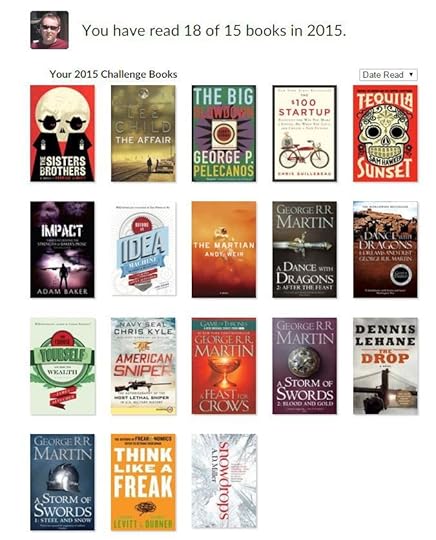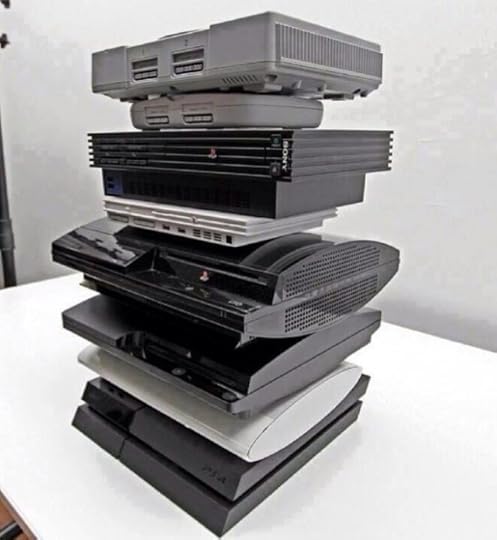T.S. Sharp's Blog
January 19, 2016
2015 – My Year In Books, Courtesy of Goodreads
For reasons that I’m not entirely sure of, I’ve got into the habit of recording the books I read over the course of a year, and setting targets for them on the goodreads.com website.
In 2014, I vowed to read 15 books, and only just met the target. Go me!
For 2015, having only just made the 2014 total, I went for 15 again, but ended up completing 18. Get in.
This is my year in books.

2015 Reading Challenge
Setting an objective at goodreads creates a useful record of exactly what you managed to read over the previous twelve months, and over time will function as an interesting glimpse of your reading habits. Four of the titles were non-fiction, and the rest were novels. Looking back, I can see I went on a massive Game of Thrones jag, with a bunch of popular psychology thrown into the mix. Which makes for a weird combination at the best of times. Anyway, here’s what I read and what I thought of them:
The Sisters Brothers – Patrick DeWitt
I think I bought this in a charity shop as part of a three for a pound deal on paperbacks, having heard that it was good from somewhere. And it is good. It’s a bit like a Cormac McCarthy novel in that it’s set in the American mid-west in the 19th century and is violent but poetically written, all of which is a winning combination for me. As a rather arbitrary measure of its quality, I will mention that I put this in the free book box at work when I finished with it, and it disappeared straight away, leaving all the dog-eared airport thrillers behind, so hopefully someone else will love it too.
The Affair – Lee Child
I’ve found that the Jack Reacher novels are basically all the same, yet I seem to find myself reading at least one of them every year. This is mostly because I pick them up cheap in charity shops or the aforementioned ‘book box’ at work, but mostly because they’re extremely readable, much to the credit of the author, Lee Child. This one, The Affair, is average, most like all the others. Reacher, the mysterious loner, stumbles into a small town and somehow finds himself embroiled in a murder investigation amid some dubious local politics. No doubt it will be the same for the next novel. Like I said, average, but they’ve become familiar to me now, like a cup of tea or browsing TV channels you’re not too interested in watching.
The Big Blowdown – George Pelecanos
I’ve loved Pelecanos’ novels since I discovered he wrote for the TV show The Wire, and The Big Blowdown is great, too. This one is set in post-war DC, following characters who feature in later novels, so it was really good to get a feel for the early days of the Greek Americans, and how his characters came to be. I love his gritty portrayals of urban life, and although this is set in the 30s and 40s, it shows how life doesn’t really change for a lot of people in certain situations. Great stuff.
The $100 Start Up – Chris Guillebeau
This was more of a curiosity read than anything else, and was one of my non-fiction reads of the year. I’ve been browsing Chris Guillebeau’s blog for a while now, so I thought I’d grab a copy of this on Kindle, mostly as an impulse buy. It’s intended as a guide to creating a quick start-up for a company, which I didn’t really have any intention of doing, but reading the case studies was really interesting.
Tequila Sunset – Sam Hawken
I read The Dead Women of Juarez a couple of years ago and really liked it, so I sought out another of Hawken’s novels to see what it was like. I think I preferred the Dead Women to this one, as this is more of a police procedural, taking place almost entirely in Mexico. I liked it, but it did have me wondering where his next novel will take us, as the gangs/drugs/border combo seems kind of run dry in these two novels.
Impact – Adam Baker
I think this is the fourth (and final?) novel in Baker’s zombie apocalypse series, and it’s more of the same, which is good, as they’re well written in a genre that is done to death (get it!). This one is set in the desert after a failed attempt to nuke a secretive location, and Baker’s short punchy writing style carries you along with it, dragging the reader through bulkheads and ripped fuselage away from increasingly sentient zombie-things!
How to Become an Idea Machine & Choose Yourself Guide to Wealth – James Altucher
A bit like the $100 Start Up, I bought this because they were both cheap on Kindle and because I follow the blogs. Of the two, the Idea Machine (written by Claudia Altucher ,with James as co-author), is the more practical, in terms of providing instructions for things you can do straight away. The idea being that everyone should always be writing ideas down, for just about everything, with the intention of over time creating an ‘idea-muscle’ that will work wonders for you. Both books are self-help books really, but they’re engaging enough.
The Martian – Andy Weir
I loved this book. Weirdly enough, it was in a James Altucher book or blog that I first came across it, as he was recommending it himself as an aside in an article I think. The science is pretty full-on at times, but it’s never off-putting, and the opening paragraph is great, setting up the tone of a book written from the perspective of someone left stranded on Mars. I was intrigued about how that would pan out into a full-size novel, but it does develop into more of a movie-plot later, hence the Matt Damon film of the same name. Must go see that, too!
Various Game of Thrones novels
I’m too lazy to list them here, but I went on an almighty binge of George RR Martin novels in an attempt to read the books before the TV series concluded. I just about managed it too, I think I finished the last one on the same day I watched the last episode of season 5. I won’t go into spoilers, but I loved them, despite having to kind of train myself on how to skim read sections once I detected that the writer was about to launch into detailed descriptions of feasts or clothing. Now, like all the other readers of GoT books, I’ll have the TV shows to watch and no books to read, which will be weird.
American Sniper – Chris Kyle
Another heavily discounted and promoted Kindle read. I probably wouldn’t have bought this otherwise, as it’s quite a polarising book. As a memoir of one of the world’s most prolific snipers, it’s interesting reading, but you have to leave your politics behind when reading it, which at times is impossible to do. I thought it could have done with a bit more consideration of the populations of the places he was operating in, but it was almost as if that was getting in the way of the basic politics of the writer.
The Drop – Dennis Lehane
Like Pelecanos, I love Lehane, as he also wrote for The Wire and other great shows. This has been made into a film which is another movie I’ve added to my huge ‘must watch at some point’ list. Sharp, crisp prose is Lehane’s forte, as is the underbelly of American cities, which for me make for a winning formula. I don’t know why, but storylines involving bags of dodgy cash and who wants it back is a great formula for me.
Think Like A Freak – Steven D Levitt
This is a book related to the successful ‘Freakonomics’ podcast, and is full of fascinating insights into how the economics of every day things effects the things we do and the lives we lead. Like ‘why do Nigerian scammers always have such ludicrous text in their scam emails’? This theory alone was worth the read. For more of the same, check out their podcast!
Snowdrops – AD Miller
This book, about a Brit in Moscow, is like a travelogue that details all the reasons you should never go to Moscow. It paints a truly horrible painting of the city and Moscow in general, which is grimly fascinating. It’s fictional, but some of the details are clearly borne from the writer’s time spent there. I’d like to think a lot of it wasn’t true, but given the book’s convincing telling, you never know.
My ‘to read’ pile is still enormous, and my goal to read twenty books this year is on track, but having completed my 2015 reading goal feels good.
Read any of the above books? Got any tips for more productive reading habits?
The post 2015 – My Year In Books, Courtesy of Goodreads appeared first on Sharpist.
November 4, 2015
How to disable annoying autoplay for Facebook videos
If your Facebook news feed is automatically playing back videos of cats or children doing ‘hilarious’ stuff, and you’d rather not have it distract you, here’s how to disable annoying autoplay for Facebook videos.
This has been vexing me more and more recently, as friends and acquaintances seem to be posting up more and more video content. On a slow internet connection, this can affect page loading times, and on mobile devices it could seriously eat data.
On a laptop or computer;
Click the downward arrow on the menu bar at the top of the page and select Settings.
On the left hand side of the Settings page is a list of options, select ‘Videos’ at the bottom.
Select the ‘Auto-play Videos’ option to ‘Off’. I think the default mode basically means ‘On’, which is very helpful of Facebook.
From now on you shouldn’t see any video clips ‘entertaining’ you as your browse the news feed.

Access Video Settings To Vanquish Auto-play
On an iPhone or Android device;
On an iPhone, go to Settings and find Facebook.
Tap Settings.
Next, tap on the Autoplay setting and choose either Wi-Fi only or Off so you don’t use a big chunk of your monthly data allotment on Facebook videos. I’d suggest ‘Off’, you can always click to play the clip if you find it enticing enough.
On Android, the auto-play settings are within the Facebook app itself. Under the General Settings, tap on ‘Video Auto-Play’ and set it to Off.
Begone, vexing vids of idiots doing idiotic stuff!
The post How to disable annoying autoplay for Facebook videos appeared first on Sharpist.
October 14, 2015
Government to restrict the use of the asterisk in advertising

The new look asterisk will replace all longer, confusing clauses
Government to restrict the use of the asterisk in advertising
The advertising industry is facing widespread upheaval after the government announced plans to force advertisers to use the asterisk more honestly when placing it after headlines and taglines in advertising.
‘*Mostly Bullshit’ will now accompany all advertising copy where an outlandish claim is being used to promote a product or service. Previously, the asterisk was the best friend to sharp-suited, latte-drinking ad execs, who willfully abused it to obscure the myriad of weasel-worded clauses and caveats their adverts contained. But recently announced government plans will see these banned, to be replaced by the much simpler text ‘*Mostly Bullshit’. The text will also have to be at least fifty percent larger than previously published, to give the buying public a clearer indication of when they’re being ripped off.
Nigel Smyth of the Advertising Standards Authority said;
“the new rules governing the use of the asterisk will bring transparency to consumers. ‘Mostly Bullshit’ will mean that banks, pizza delivery firms, and double-glazing companies can no longer fool us with small-print clauses that make us poorer, and whiskey-swilling philandering chauvinist ad-men richer”.
Don Sterling, campaign and marketing manager from Hoxton-based advertising agency Lowe, Ingersoll, and Evans, said the new rules would punish the industry.
“The asterisk is a much-loved institution of the marketing world. Without it, how are we meant to sell over-priced, bad quality sofas with exorbitant interest rates with big banner adverts accompanied by minuscule text hiding the reality of the piss-poor deals being offered? Lies need to be expertly hidden in plain sight, not made clear to the consumer.”
Industry analysts suggest this will lead to the complete extinction of toothpaste, bleach, and car finance adverts.
The post Government to restrict the use of the asterisk in advertising appeared first on Sharpist.
May 11, 2015
Ten Reasons Why A Games Console Is One Of The Best Investments You Can Make

Think of all the entertainment value this stack of old games consoles contains.
If you were to buy a new games console every time the next generation of gaming systems was released, you can expect an average of about six years between purchases. At between £300-400/$400-$600 per unit, consoles don’t fall into the impulse buy category very easily, but with several years between releases, the investment is still a good one. It won’t make you money (unless you’re one of these guys), but money isn’t the only thing of value to consider when looking at investments, is it?
On average, the new generation of consoles comes out every six years.
Microsoft Xbox
Year
Console
2001
Microsoft Xbox
2005
Microsoft Xbox 360
2013
Microsoft Xbox One
Sony Playstation
Year
Console
1995
Playstation
2000
Playstation 2
2006
Playstation 3
2013
Playstation 4
As long as you don’t suffer anything as catastrophic as the RROD, your console will serve you faithfully for years. I’ve owned a Playstation 2 and a Microsoft Xbox 360 over the last fifteen years and both have been as reliable as a Japanese-built Toyota. I’ve just bought a PS4, and I don’t expect to buy another console for the best part of ten years.
Put simply, a games console is one of the best investments you can make . Here are ten reasons why;
Consoles Last For Years
Even allowing for the abuse a console can sometimes suffer at the hands of over-excited teenagers, you can expect to get a decade’s worth of gaming out of your average Playstation or Xbox. Even if you bought the new version on the day of release, you’d get about six years out of it. Average price £350 / 10 years = £35 per year. Or £58 a year if you bought a new unit every six years.
So Many Great Games
Over the years you own the console, several awesome games will have been released to the market. These form gaming milestones. All the Grand Theft Auto games, the Call of Duty series, The Last of Us, the Battlefield series, Minecraft, Metal Gear Solid, various Rock Band versions. All sorts of games in all sorts of genres. Think about how many great games there will have been over a ten year period.
Just enjoy the scenery in Grand Theft Auto V…
Countless Hours Of Entertainment
Depending on the type of game, there are hours of game-play time in the story mode of a release. That’s not including all the hours you can spend driving around the Sonora Desert in GTAV, or trying to breed a golden Chocobo bird in Final Fantasy VII. Compare that to the time you spent watching the last DVD you bought. The odds are you’ll never watch that disc again. Or that novel you read – you might read it again, but you won’t read it over and over again and enjoy slightly different nuances each time you do. And this doesn’t include online multiplayer gaming.
The Social Aspect – Online Multiplayer Mode
The image of a teenage boy locked away in a darkened room interacting with no-one is no longer very accurate. Pretty much every single game release has an online mode for players to play against other gamers. Just like Facebook and Twitter, gamers add their mates to their friends lists on their consoles and regularly hook up with them, either through gaming or via the mic-headsets. People are way more connected to each other than they ever were before, and games consoles are no different.
The Social Aspect – Pass The Controller On The Left-Hand Side
On its release, the Xbox 360 was touted as a media centre as well as a games console, with the idea that it could store and stream music, film and TV, from services such as Spotify and Netflix. It’s remained the same way with modern consoles in the development of the PS4 and the Xbox One. So as well as playing games with friends and family, consoles can be the focal point for social interaction. If you watched a film with friends, it would last about two hours. But you could spend an entire night playing Rock Band with your mates or bemused older relatives.
Not Just Games
From the Playstation 3 and Xbox 360 onwards, consoles have become media centres and entertainment hubs. With access to the internet, gamers can now watch TV through Netflix and Amazon Prime etc, use apps, and generally browse the web. Theoretically a console replaces the need for a conventional laptop or cable TV package.
Return On Investment Only Increases With Use
The more you use your console, the more value you get out of it. Imagine you buy two pairs of shoes, one for £10 and another for £100. You never wear the £10 pair, but you wear the £100 ones all the time. The £100 pair of shoes was the better investment. You wasted £10. If you’re playing games, the average minimum time spent playing in a single sitting is likely to be one hour. A couple of sessions on the console a week adds up, making it potentially one of the most heavily-used pieces of technology over its lifetime.
Console, Games, & Accessories Can Be Re-Sold
Over the course of a console’s tenure in that prime spot beneath your television, you’re likely to have bought several games. Once completed or grown tired of, these can be sold or exchanged for newer products. I’ve done this with just about every game for every platform I’ve owned. Games and accessories, as well as the console unit itself, have relatively high resale values. I remember selling my PS2 and everything that it came with, including games and the original box, for close to £100 when I upgraded to an Xbox 360 about ten years ago. Not only did I off-load unwanted possessions, the money raised made a dent in the cost of buying the new unit. The longer you hold on to old technology, the more the value drops.
It’s Also A DVD/Blu-Ray Player
The days of having a stack of black and grey plastic boxes beneath your TV to meet your entertainment needs is long gone, thankfully. A DVD player, a cable or satellite box, a games console and perhaps a VHS player would have sat there, mournfully reminding you of all the money you’ve spent over the years in an attempt to keep up with technological advances. For those times when you do need to play media from a physical source, the games console has that covered too. Take that DVD player to your local recycling centre.
If You’re Playing Games, You’re Not In The Pub
OK, there are times when you’d rather be in the pub. Quite often in fact. But a Saturday night spent in front of the games console playing through the delicate narrative of something like The Last of Us, or watching the hilarious exploits of characters such as Trevor Phillips in Grand Theft Auto V is way cheaper than a round of drinks, not to mention much easier on your liver. A night out can cost anything from upwards of £20, and often leads to a bad hangover the following day. There are no such issues with a night of gaming. Unless of course you get through a crate of beers while playing, but hey, knock yourself out…
I didn’t mention the Nintendo Wii, did I? That’s because it’s not a real console with real games. If you bought a Wii, then you’ve probably already wasted your money. Sorry.
The post Ten Reasons Why A Games Console Is One Of The Best Investments You Can Make appeared first on Sharpist.
April 2, 2015
Ten Best Product Adverts On Grand Theft Auto V
Ten Best Product Adverts On Grand Theft Auto V

GTAV’s finest beer.
Grand Theft Auto V is one of the finest video games ever made, for all sorts of reasons.
If you want to take time off from running all kinds of insane criminal hustles to earn one of the three main characters some cash, there are millions of things to amuse yourself with. Sky diving. Bowling. Hacking.
But one of my favourite GTA V past times is simply driving around exploring the city. Los Santos is basically Los Angeles, and its video game alter-ego is only slightly more insane than its real-life counterpart. One of the gems of Los Santos as imagined by the developers Rockstar Games is the level of detail they’ve put into making the city resemble a real, living breathing animal. It’s worth paying attention to the satire-heavy trappings of games like these, as they add yet another layer of brilliance to the game-playing experience.
The city is awash with hoardings, logos, posters, and advertising paraphernalia, but in this post let’s see a sample of the best products on offer. So let’s look at ten of the best adverts seen around Los Santos.
Clever, witty, satirical, but also gross, scatterlogical and often childishly puerile. You gotta love ‘em.
Strap On Time – Seen in the up-market business district of Los Santos, this is a childish piss-take of a Tag Heuer or Breitling advertisement.

TotalBankers – Schlongberg Sachs – Continuing the theme, here’s a financial product mixed with a dick joke.
Schlong! Sachs! *hehehehe*
Gussèt – This is probably what an ad agency would do if they had complete freedom from a lingerie client to advertise as they pleased.
I’m sure lingerie adverts like this already exist.
Take A Whiz Anywhere – Get it? Combining yet more toilet humour with a mock advert for a cell phone company.
A 9G cell phone? We’re almost half way there already…
Destroy The Ring – I’m assuming this is an ad for the Los Santos equivalent of NBA or its local basketball team, humourously throwing in a butt sex gag for the fun of it.
Butt-sex jokes never get old.
Mile High Club – An advertisement for an apartment block. Two jokes in one here – the obvious reference to a sexual act performed at altitude, as well as the fact that it’s being built by a company called STD Contractors.
The best part of this gag is almost hidden – STD Contractors!
Cash For Dead Dreams – This is a pretty accurate satire of how those ‘Cash 4 Crap’ type businesses work. Incidentally, the cashfordeaddreams.com url takes you to a Rockstars official GTA website in case you were tempted to go there. I was.
This pretty much sums up the cash for stolen goods market.
The Erotic Dream Every Woman Longs For – This is ‘Fifty Shades of Gray‘ if it existed in GTA-world. I love the individual titles of the trilogy; Chains of Intimacy, The U-Bend of Intimacy, and Plug of Intimacy.
I bet these are no different to the 50 Shades of Gray books.
On The Game – Another ‘two for one’ deal on smutty jokes here. ‘On the Game‘ is a mostly British idiom for prostitution (bear in mind that Rockstar are a British company, so that makes sense), and the ‘Double P’ is an allusion to ‘double penetration’ (Google that if you’re not at work and not easily offended). Either that or I am so childish that I cannot see anything without making it into a sex-gag.
Not just a basketball poster!
Krapea – This one is brilliant in that it is exactly the kind of advertising IKEA employs for its products. It’s simple, effective, and direct. Apart from in this case it lampoons IKEA’s affordable products.

IKEA make these jokes easy for the people at Rockstar.
These are just the ones I noticed myself during my travels around Los Santos. Imagine all the hidden gems I missed. In fact, if you’ve got some great examples I’d love to see them.
Remember, it was someone’s job at Rockstar to come up with all these ideas and designs. They got paid to come up with stuff like ‘STD Contractors’ and ‘Take A Whiz Anywhere’. I want that job.
See also – Did Showtime, the makers of the TV series Ray Donovan, steal the idea from the video game Grand Theft Auto 5? & Part II
The post Ten Best Product Adverts On Grand Theft Auto V appeared first on Sharpist.
March 9, 2015
How To Cure ‘Malfunction Anxiety’

Get your tools out to help fight malfunction anxiety.
How To Cure ‘Malfunction Anxiety’
If you own Things, those Things will break.
The older you get, the more Things you will own.
They start off small, but they get larger, until ultimately you own the largest Thing you will ever own – a house. Which is, of course, nothing but an expensive repository for your Things. Every room in your house is full of Things.
Things everywhere.
And when you own Things, the Things break. One minute your phone just works, the next it doesn’t. Your boiler? It heats the house, then it doesn’t. Your car? A rolling collection of stuff waiting to go wrong.
Sometimes it can feel like the Things are conspiring against you. By definition a broken Thing is never convenient. Have a huge mountain of laundry to do and no clean underwear? Uh-oh! Sorry, this appliance is refusing to comply. Add to that the worrying rattle in the car, and the ever-slowing response time of your laptop, and it can be a real pain in the arse.
It’s what I call ‘Malfunction Anxiety’.
It’s the vague sense of being unsettled, knowing that something once reliable and often invisible is now defying you. It’s complicating your day. It’s costing you money. Anxiety, in any form, is something you want to eliminate from your life whenever possible.
There’s a cure for Malfunction Anxiety – fixing Things.
When Things break, they can often be fixed, and fixed by you. Doing it yourself saves you money as well as teaching you a skill. It might not be something ultra technical or very specialised, but it’s something you never knew before, but now you do. I’d suggest you stay away from gas and electrical equipment unless you know what you’re doing, but most other things can be fixed with a bit of research, time, the right tools, and sometimes a small monetary outlay.
Not long ago our washing machine started making an unhealthy grinding noise towards the end of its cycle. I grimaced and backed away slowly, hoping it would magically fix itself if I left it alone. Of course, this didn’t happen and later I found it dormant and still full of water. But helpfully it was displaying an error message. The manual was next to useless, simply pointing me to their engineer call centre. So of course I did the next obvious thing – I went online. The error message was apparently related to the filter pump, and several forums and YouTube videos suggested it was an easy fix.
And so it was. Remove the kick-plate at the front of the unit, drain the water from the pump outlet, and remove any blockages. In this case it was a bra wire. I probably spent longer reading forum posts about the problem than I did fixing it. As soon as it was all back together, I was doing another laundry load.
So in this instance I went from ‘malfunction anxiety’ to smug self-satisfaction within an hour. How much would an engineer have cost? Hard to say, but I’d assume it would have been between £50 – £100. But the real saving, or earning, is the fact that I did it myself. I now know how to fix this problem. I am no longer afraid of a Thing. I no longer have ‘malfunction anxiety’.
This is the way to look at it when Things break. They’re setting you a challenge, and thanks to the internet you can excel at completing this challenge. I’m always amazed when people complain about something not working or behaving strangely, but haven’t bothered to Google it. If your Thing has broken, you can be sure someone else’s has too, and more importantly, they’ve moaned about it on the web and been directed toward a fix.
Your friends and colleagues can also be good allies in the war against Things.
Another case study:
The boiler in our house suddenly started vomiting water all over the place. Instead of calling a plumbing company and waiting ages for them to arrive, and then pay the subsequent bill, we phoned a friend of ours who is a plumber but lives miles away. He ran through the steps to stop the water escaping, reconnecting the blown hose, and then to re-pressurise the boiler. Not long after it was all working again. Running to a repair company would have cost time, money, and more importantly, would have denied me the knowledge I now have.
(Whilst I did point out that messing with gas and electric supplies is not recommended, I was 100% sure in the case above that this had nothing to do with the gas supply, so I was confident doing it myself)
There’s another huge benefit to fixing broken Things, and that’s waste prevention. We’ve become far too accustomed to throwing Things out when they’re broken, simply because we think they can’t be fixed, but more likely because we can’t be bothered. Easier to buy a new laptop/washing machine/lawnmower than work out what’s wrong with it in the first place. Companies love that we think this way. They make it easy for us to replace old-with-new, just so they can sell you new Things. Which will, of course, eventually break.
“Daddy fix it.”
Now that I have children, I am often faced with this scenario; I am handed a broken toy or another random household item and told ‘Daddy fix it.’ It’s a great example of the heart-breakingly simple logic that children employ - ‘I’ve encountered a problem, but don’t worry I know how to resolve it’. They hand the broken Thing over to an adult and all is solved. Often it’s not solved, and the adult has to find a way around that issue too.
Garbage Finds is one of my favourite blogs on the subject of waste, and in this case how to profit from other people’s broken Things. The blogger scours the streets in his native Montreal to look for discarded treasure, and he’s pretty damn successful too.
Here’s a list of the Things that have broken over the last few months and I’ve been able to fix myself, earning some smug self-satisfaction along the way;
Vailant Boiler – The heating boiler blew a hose and emptied its contents all over the floor. Once I’d stopped panicking about the very minor flooding I was able to shut it down, re-attach the pipes to the fitting, re-pressurise it and get it going again. Very satisfying, as no boiler = no heating or hot water.
Washing Machine – A blocked filter pump meant the whole thing ground to a halt, mid-cycle. Accessed the pump, drained the water and got it running again in less than an hour.
Vibrate function on iPhone – I noticed that this had stopped working. A quick browse of the internet suggested that a sharp tap on a hard surface should get it going again, and so it did. I like this fix, as it involves a small amount of dumb, brute force on a highly sophisticated piece of technology.
Petrol Lawnmower – This was running rough and eventually just stopped running. I went online, read a few forums and watched some videos and diagnosed the issue as old petrol and a clogged carburetor. Now it’s running great.
If it worked, then broke, and then you fixed it, you win!
The post How To Cure ‘Malfunction Anxiety’ appeared first on Sharpist.
January 23, 2015
Jihadi fakes his death and returns from the dead – How life imitated my blog post.
In October 2014, I wrote this blog post – offering up the plot of a film or TV show based around the idea of a jihadi faking his death to return home.
Imagine my shock when I read this news story.
It’s basically exactly the same concept, but this was real life. It looked like life had imitated one of my blog posts.
In more detail, here’s the crux of the two scenarios, one merely conceptual, and one real, but both have exactly the same basic principle; a Western jihadi fakes his death in the Middle East in order to return home undetected.
In October 2014, whilst following many of the news stories that came out of Syria and Iraq about the rise of Islamic State and the potential threat of homegrown terrorists returning from overseas conflicts, I was struck by an idea.
The press in the UK had intermittently been reporting on the deaths of British citizens who had gone to fight with Islamic groups in the Middle East. Typically, their deaths came to the media’s attention via social media. It was not a great stretch of the imagination to imagine MI5 terror analysts looking at these reports and ticking off the names as they were reported killed.
But what if they weren’t really dead?
A good way to return to the UK, or anywhere else for that matter, without the unwanted attention of the security services would be to do so as someone else entirely. What better way to stop people looking for you than if everyone thinks you’re dead?
So I wrote a brief blog post outlining this concept to reflect my musings on the subject. I packaged it up like a potential storyline for a film or TV series. After all, it’s not too dissimilar to the plot of Homeland.
Read the post here.

Aleppo, Syria (Javier Manzano/AFP/Getty Images)
Now, in January 2015, the media reported a story about exactly the scenario I described. Imran Khawaja, 27, of Southall, west London, traveled to Syria to train and fight, and had then been falsely pronounced dead via social media. He was subsequently arrested in Dover while trying to re-enter the UK, under a false identity.
Read the story here.
The news has only recently been released now that the case has been heard in court, but the events all took place last year, way before my vague ramblings on the matter, but it shows that I was not the only one who had considered this idea. No doubt this individual is not the first to have tried this, and there’s no real way of knowing if it has indeed been successful in the past.
This seems to be a strange case of life imitating blog posts. It shows that ideas can be generated from pretty much anywhere. News stories are often larger than life examples of real life, often sounding too outlandish to be real. Yet they make great stories for films, TV, and novels.
Next time you see or hear a dramatic news story, think about how it would play out on the screen…
The post Jihadi fakes his death and returns from the dead – How life imitated my blog post. appeared first on Sharpist.
January 21, 2015
Get Hangovers From Excessive Drinking? Blame Your Parents

Now you have an excuse for your hangover – your parents. Alas, there is no decent cure, though.
Get Hangovers From Excessive Drinking? Blame Your Parents
Research into the affects of alcohol consumption has suggested that hangover tolerance might well be down to an individual’s genetic makeup. According to LiveScience, half of the reason you feel bad (or don’t) is due to the genetics you’ve inherited.
That might explain why some of us can shake it off almost entirely the next day, while others are sofa-bound, vowing to never drink again. Think about the last time you drank heavily with a group of friends. Almost certainly there will be a group of so-called mates who pointed and laughed at those who locked themselves away in a dark room and took a vow of sobriety.
I’m one of the latter. My hangovers last double the amount of time the drinking session did.
Recently I went out for a curry and some beers with the lads. I met the guys in a pub at about 8pm, and stumbled in at about 3am. I was drunk enough to know that I was going to have a hangover the next day, but too drunk to do anything about it.
My options were limited though. I could stay up and let the alcohol levels die off, but it was already gone 3am, so this was not really an option. Or I could drink litres of water and hope it would help to rehydrate me enough to make the next day bearable. In either case, I don’t think it would have made a massive difference.
In the end I downed a pint of water and stumbled into bed, where I fell immediately asleep, but not into the good kind of sleep, but into that comatose, possibly flirting with death type of sleep you get from excessive drinking.
The next day, I woke up feeling merely tired. I was chuffed that I’d dodged the hangover bullet. Over the course of the night I think I must have drunk about six pints as well as two or three rum and cokes. There were four of us, and at least two rounds were bought per person, so let’s just say I drank a lot. Too much. So where was the dreaded hangover?
It was waiting for me. It turned out the strange calmness of stomach and only vague sense of a headache were just the affects of legacy booze. My wobbly steps and inaccurate motor-skills should have been telltale signs. Because then it hit me like a tsunami of nausea and raging head-pains.
One of the ways hangovers manifest themselves in me is a total lack of appetite. A few years back I attended a wedding on the Cote d’Azur in France. Needless to say, it was a swanky affair. Free booze, mostly champagne, and lots of reasons to celebrate.
The following day was fully catered for by chefs and serving staff providing breakfast and again, all free. My mates piled in. Coffee, delicate continental pastries, fresh fruit, as well as cooked breakfasts for us Anglais. It was the last thing I wanted to see. Instead I sat in a corner and fought the nausea, until eventually I had to vomit, which I did several times, despite not eating anything other than a couple of mouthfuls of fruit.
So this particular morning, after curry and beers, I was starting to feel the pain. My defence strategy in fighting the effects of a hangover is not particularly robust, I must admit. It mostly consists of lying down and feeling sorry for myself.
But nowadays I have child care responsibilities. Any parent will tell you that kids don’t care about how much you drank the night before. All they’re interested in is watching kids TV at full volume and jumping on you.
The daddy daycare was going fine until, like many times before, I just had to puke. This was at about 2pm or something. I knew it was coming. The churning stomach was telling me so. But this time, I looked up to see my daughter watching me pay the price of my previous night’s revelry. Not a good moment, for me or her.
And all this, I blame on my mum.
I remember complaining to her once about a hangover (I should have been complaining about my drinking, really) and she told me we were the same – totally intolerant to the after-effects of drinking. In fact, at my wedding, I remember her saying she was planning to drive the family back to the hotel afterwards as she wasn’t planning to drink, simply because she knew the hangover would be crippling. I’m beginning to see her point.
So that’s where I get it from.
My dad on the other hand, can drink his body weight in booze and seemingly walk away from the train-wreck of a hangover that I would have suffered. The article points out that being genetically predisposed to not get hangovers might carry greater risks of alcohol addiction. A silver-lining, I suppose.
People who are less susceptible to having a hangover might have a greater risk for alcohol addiction, the researchers said.
I can see myself taking my mother’s approach to drinking in the future – not really drinking excessively due to the tyranny of the hangovers. Which must be a good thing, surely?
So there you have it. Blame your parents (or don’t drink too much).
The post Get Hangovers From Excessive Drinking? Blame Your Parents appeared first on Sharpist.
December 15, 2014
2014 – My Year In Books, Courtesy of Goodreads
2014 – My Year In Books, courtesy of Goodreads.com
How many books do you read in a year? For 2014 I kept track using Goodreads.com.
Like previous years, I’ve set myself a target number of books to read over a twelve month period, and recorded the progress on Goodreads.com. This is my year in books.

2014 Goodreads Books
I wrote about last year’s target here. This year I wanted to read at least fifteen books.
In comparison to a lot of people I probably don’t read that much, but my reading time has been curtailed somewhat by having a toddler in the house. I only just about managed to reach the target.
Setting a goal and recording the titles in Goodreads is an interesting exercise as it gives you a chance to look back over what you’ve read in the previous twelve months.
Of the fifteen, ten were fiction books, and five were non-fiction. In total it was six e-books and nine physical books which is the same breakdown of electronic and physical books as last year. Here’s a list of the books and what I thought of them;
Mockingbird – Chuck Wendig
This is the second in the series of Wendig’s novels about a woman who can foresee the deaths of those she has physical contact with. Like his other novels, this is sweary and violent and fast-paced in a way you’d want your Wendig novels to be. I did notice a few glaring typographical and formatting errors, but according to the author these are known issues, set to be addressed in later editions. Does that make my copy a collector’s edition?
Between Here And The Yellow Sea – Nic Pizzolatto
A collection of short stories from the author of Galveston and the writer of acclaimed TV series True Detective. I loved True Detective, so I bought the Kindle version of Galveston, which I also loved, so I bought Between Here And The Yellow Sea in an attempt to hoover up all of Pizzolatto’s work. The book has a variety of settings and characters, and some of them are more engaging than others, but generally it makes great reading. I kind of got the impression this was released or re-released in haste in order to fill out Pizzolatto’s back-catalogue, but it was still worth reading.
Freakonomics & SuperFreakonomics – Steven D Levitt & Stephen J Dubner
Did you know kangaroo farts don’t contain methane?
This is just one of the many facts I learned from reading these two books about micro-economics. The Freakonomics books, and the excellent podcasts, are full of strange social quirks put under the microscope of economic scrutiny. While some of the assumptions and facts have been debunked since publication, these books, and the third in the series, Think Like A Freak, are still fascinating reads. Economics as a subject is a dark art, full of conjecture and complexity, but these books are written with that in mind – take something everyday and relate-able and apply economic models to it. The results are often pretty amazing.
George Pelecanos – x3 Books (Shoe Dog, A Firing Offence, Down By The River Where The Dead Men Go)
Looking back, I went on a bit of a George Pelecanos reading-spree this year. I bought Shoe Dog, A Firing Offence, and Down By The River Where The Dead Men Go – all of which I enjoyed. The problem with reading several books by the same writer in a short period of time is that you run the risk of them becoming a bit samey, and whilst the themes, settings, and characters were very similar, I still enjoyed them. I’ve often thought reading Pelecanos’ novels are like reading a script from an episode of The Wire. Not surprising since he wrote numerous episodes. Love him as I do, I think I’ll take a break from the grimy Baltimore backstreets for a bit.
Nothing To Lose – Lee Child
Jack Reacher is hitchhiking somewhere, he happens to cross paths with someone who needs his help, he does a bunch of ass-kicking, and then carries on hitchhiking.
That is basically the start, middle, and end of every Lee Child novel. I’ve read three or four of his books so far and I’ve yet to see one that has a drastically different premise. Child’s writing is tight and economical, but I can’t help but think his books are written with the aid of a Word template document.
A Clash of Kings – George R R Martin
The second book in the Game of Thrones series – except it’s not the Game of Thrones series at all, it’s the Song of Fire and Ice series, but that’s a rant for another day. I love the TV show, so naturally I’m reading through the books for the extra depth you can’t get from television. I’m enjoying the stories, but you have to learn a special skill to read Martin’s books in order to skim through a lot of the added weight he insists on throwing in. Once you’ve developed this, these bricks of books are enjoyable reads.
30 Second Economics – Donald Marron
A non-fiction book about economic principles, but a very different beast to the Freakonomics books. This is a bit like a cheat-guide for economics students – it basically summarises the main economic theories of the last three hundred years, with neat little graphics and quotes. I can see myself referring back to this book to get a better grasp on some of the economic terms we’re likely to hear on the news.
Blood Fugue – Joseph D’Lacey
This horror novel was written by an old writing tutor of mine. I bought it on Kindle and chipped away at it in small chunks over a period of a month or so. I don’t read much horror, but I’d say this is a mix of vampire and apocalypse fiction, with a fair amount of sex and gore thrown about. Not too dissimilar to his writing classes, actually.
This Book Will Teach You How To Write Better – Neville Medhora
Whether or not this book did teach me to become a better writer is up for debate, but this book is primarily geared towards copywriting for commercial purposes. It’s short, snappy, and to the point, which I suppose is the main aim of business writing aimed at selling products and services. Medhora has a great blog which I only discovered after reading the book, but the two things are very similar – punchy and aimed at getting you started on projects to make money.
Galveston – Nic Pizzolatto
I loved this book, it has to be my favourite read of the year. Part-way through watching True Detective I just had to root out his literary work, so bought Galveston on Kindle for the bargain price of £1.99 or something. I nailed through it in a week or so – impressive given my relatively slow reading pace. Like True Detective, it’s set in the murky backwaters of Galveston and surrounding Texas, following broken down anti-heroes with tight, punchy prose. To say this kind of Cormac McCathy-esque writing is up my street is an understatement.
The Crimson Petal and the White – Michael Faber
I bought this on Kindle after watching the BBC dramatisation. A Victorian prostitute climbs the social ladder when she becomes the nanny for the child of a wealthy customer. The prose is just as grimy as some of the settings, and at times it reads like Faber couldn’t bring himself to edit out some of the details he uncovered whilst doing the research, as the book is a mighty tome. It’s well written, but at times it wallows in the minutiae of Victorian life in London a bit too much.
The Junior Officers’ Reading Club: Killing Time and Fighting Wars – Patrick Hennessey
This is the memoirs of an officer in the British army during his time in Iraq and Afghanistan. These books are ten a penny nowadays, and I’ve read several now. Some are better than others, and I think it all depends on the individual recounting their experiences, and who their ghostwriter/publisher is. This is one of the better titles, although I am finding the writer’s long, run-on sentences a bit distracting. This is probably deliberate, to give the book a distinctive voice, but it’s something the reader has to deal with when reading it. It certainly covers some of the more frantic, violent episodes of Britain’s military role in Afghanistan, and is recommended for this aspect alone.
These fifteen books make a minor dent in my to-read pile, but it’s good to see them laid out on Goodreads.
How many books do people read in a year? I’ve got a feeling my total is pretty low. So many books, so little time…
The post 2014 – My Year In Books, Courtesy of Goodreads appeared first on Sharpist.
November 12, 2014
10 Movies I Have Never Seen

Film Scripts. Among these titles are films I’ve never seen
So many films, so little time. Don’t let articles that list films ‘You Must See’ intimidate you.
Even if you’ve seen a lot of movies, there are always some notable titles which will have passed you by. So on that note, here’s a list of films, in no particular order, that I have never seen.
Some of them might elicit an ‘WTF? How can you NOT have seen it? Everyone has seen that movie…‘ but so what. Let me know if you haven’t seen any of these either.
Star Wars
Of course I’ve seen the original three films, plus Episode I – The Phantom Menace, and they’re all great (well, Phantom Menace is average), but the rest kind of passed me by.
Maybe because I wasn’t an uber-fan in the first place, but the later films just don’t interest me. I’ve seen snippets of the various films when they’ve been on TV, but the high-camp play-acting style of drama doesn’t appeal to me. Plus, I’ve become totally intolerant to movies with an omnipresent musical soundtrack throughout the whole film. It’s like they can’t possibly have a sequence without a score playing in the background.
The whole Star Wars franchise seems like an unstoppable juggernaut with an ever-expanding cast, as if the whole thing only exists to keep the CGI industry busy. Star Wars, for me, is generally just ‘meh‘. Apparently there’s a new one in the pipeline. I probably won’t see that either.
The Lion King
I know. I know.
It seems like people have been born with this film auto-installed into their consciousness. But not me. I was a teenager when it came out, so I wasn’t interested in seeing it then, and obviously didn’t have kids either, so there was no obvious reason to cross paths with it.
Plus, as a Disney musical it’s generally not the kind of movie I’d make a special effort to see. I imagine I’ll end up watching this with the kids at some point though.
Harry Potter – all of them
This is not strictly true. I’m pretty sure I’ve sat through the first movie one Christmas, but I remember nothing of it, which is proof that I gave absolutely zero shits about it. Therefore I have no interest in seeing the rest of the films, or reading the books for that matter.
Maybe if I’d read the books I’d be more interested in the movies, but that ship has sailed.
Gravity
Judging by the vast amounts of money this film has made since its release in 2013, it looks like everyone has seen this film, many of them at least twice. But not me. Don’t get me wrong, I do want to see this movie, and I reckon I’d really like it, but I never got around to it when it came out. At some point this will be on regular TV, and I’ll definitely watch it.
Citizen Kane
This film is on just about every ‘films you MUST watch before you die’ list, but let’s be honest, unless you’re a movie-buff or a film and television lecturer it’s unlikely you will have watched this. That’s not to say it isn’t a cinematic masterpiece, but it’s a movie you have to commit to.
You can’t just chuck this one on in the background while you browse twitter. You have to be shut inside away from the rain with two hours to spare. You have to drink this film in. I’d like to think I’ll make room for this movie one day, just to see what it’s all about.
Psycho
Like Citizen Kane, this is a film that needs to be appreciated. I might well have seen parts of it, but I’m pretty sure I’ve never seen it in its entirety. Movies like Psycho need to be watched properly to appreciate the famous clips we’re all familiar with. That way, the context has way more impact. Removed from the whole, the shower scene loses something. I haven’t avoided this film, it’s just never been on when I was browsing TV stations for something to watch, or if it was, it was halfway through.
The Hangover (All)
Like cinematic ships that pass in the night, I missed the first one and the subsequent films have piled up in the background, unwatched. I suspect I’ll love these films, but alas, have not got around to them.
Like a lot of the movies I haven’t seen but everyone else has, I think this is to do with my very infrequent trips to the cinema. I’m not in the habit of browsing the film listings at my local multiplex and picking a movie to watch, so I miss a lot of new releases. These films are out there, somewhere, waiting for me to invest a couple of hours in.
300
This film, like Sin City (which I have seen), is pretty much of its time. That time has passed, and I think so has my interest in seeing it. Both films use a super-imposition chroma key technique to replicate the Frank Miller comics from which they are based, and while interesting in the mid-noughties, it has less appeal now. I might well half-watch this one night when the kids are in bed, but I won’t be seeking out a DVD copy any time soon.
The Graduate
‘What? You’ve never seen The Graduate? No way!’ is pretty much what people say when you tell them you haven’t seen it, but it’s true.
I’ve seen several chunks over the years, but I can’t say I’ve watched it from one end to the other. I’ll get around to it one day, I promise. Just like that IKEA chair which needs assembling, but has been sitting in a cupboard for over a year. You throw a quote from the movie at me, I can probably pin it to The Graduate so iconic is the film, but I can’t lie and tell you I’ve seen the whole movie.
Gone With The Wind
This film is too long. I know it’s a cinematic legend for all sorts of reasons, but I can’t ever see the day when I’d willingly put aside this much time to watch it. Also, see point 1 about omnipresent film scores, they really get on my nerves. At least GWTW has an excuse in that it was all the rage in the 30s and 40s. Everyone else – stop it!
There are a lot more movies that could have made the list. When I looked through the various ‘films you must see‘ articles on imdb or Rotten Tomatoes, I realise I have watched most of them. So I’m not a total weirdo.
New releases are coming out all the time, and a lot of them look like they’re worth checking out, so the ‘Never Watched’ list is likely to grow over time.
Seen these films? Recommend them? Ones to miss?
The post 10 Movies I Have Never Seen appeared first on Sharpist.














